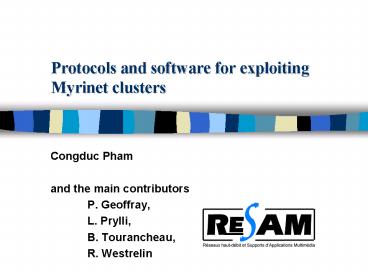Protocols and software for exploiting Myrinet clusters - PowerPoint PPT Presentation
Title:
Protocols and software for exploiting Myrinet clusters
Description:
Performance of workstations and PCs is rapidly improving ... Use DMA both on the send side and receive side: higher bandwidth, offload the CPU ... – PowerPoint PPT presentation
Number of Views:44
Avg rating:3.0/5.0
Title: Protocols and software for exploiting Myrinet clusters
1
Protocols and software for exploiting Myrinet
clusters
- Congduc Pham
- and the main contributors
- P. Geoffray,
- L. Prylli,
- B. Tourancheau,
- R. Westrelin
2
Parallel machines and clusters
Cplant
Standalone workstation
3
Pros for clusters
- Large supercomputers are expensive and suffer
from a short useful life span - Performance of workstations and PCs is rapidly
improving - The communications bandwidth between workstations
is increasing as new networking technologies and
protocols are implemented in LANs and WANs. - Workstation clusters are easier to integrate into
existing networks than special parallel
computers. - Use of clusters of workstations as a distributed
computing resource is very cost effective -
incremental growth or update of system!!!
4
No polemical discussion, just statement
Mainframe
PC
Workstation
Mini Computer
1984
Vector Supercomputer
GigaEthernet Giganet SCI Myrinet
from R. Buyya
5
The Myrinet technology
- Switch
- full crossbar
- wormhole source routing
- small latency
- Network interface
- embedded RISC processor
- programmable
- local memory
- several DMA engines
Current specifications Up to 200Mhz
processor Up to 8MB local memory 64bit/66Mhz PCI
bus (528 MB/s peak) 250 MB/s full duplex links
6
The raw performance is here, but
- the traditional communication software fail to
bring the hardware performance to the applications
200mph
40mph
35mph
Myrinet
Traditional communication layers
180mph
175mph
Optimized communication layers
7
Going faster by taking shortcuts
8
Our communication architecture
- Provides a complete suite for high-performance
communications.Focus on Myrinet-based clusters - Viewed as layers, but by-passes as much as
possible the OS
MPI-BIP
BIP
BIP-SMP
programmable NICs break the traditional spatial
distribution of tasks
Myrinet physical layer
9
BIP, the lowest protocol level
- Basic Interface for Parallelism
- very basic API
- provides a library, a kernel module and a MCP
- definitely not for the end-user
- Optimizations for
- latency
- maximum throughput
- the throughput increase
- The implementation performs
- reduction of the data critical path
- distinction between small and large messages
- burst or write combining for host?NIC
- optimal cache usage
- cache snooping for NIC ?host (monitoring of the
PCI bus) - buffer alignment
- optimal fragment size
10
BIP, small message strategy
- Avoids handshakes between the host and the NIC
- Uses PIO to a NIC FIFO on the sending side and an
extra memory copy on the receiving side
11
BIP, large message strategy
- Use DMA both on the send side and receive side
higher bandwidth, offload the CPU - Zero-copy mechanism, pipelined transmission
12
BIP-SMP a low level for SMP machines
- SMP viewed as best performance/price ratio
architectures (2 or 4 proc.) - BIP-SMP provides
- manage concurrent accesses to the NIC
- low latency intra-node communications
- BIP equivalent inter-node communication
- total transparency for the applications and
end-users
0 1 2 3
13
BIP-SMP Moving data between processes
14
MPI-BIP the communication middleware
- MPI-BIP adds high-level features to BIP
- based on the MPICH implementation
- provides a portable and widely-used API
- implements a credit-based flow control for small
messages - request FIFO for multiple non-blocking operations
- provides segmentation/reassembly features to
avoid timeouts
15
Working with the BIP software suite
- installation
- run configure
- compilation and linkage
- several libraries bip, bip-smp, mpi
- compile with bipcc
- Submitting jobs and monitoring nodes
- run myristat to know which nodes are available
- run bipconf to configure the virtual machine
- use bipload to lunch programs
16
WebCM a high level management tool
- web-based management tool
- integrates existing solutions into a common
framework
17
The WebCM user interface
- graphical interface for myristat and bipconf
- allows submission of jobs through batch packages
- shows the user's virtual machine definition and
the user's runnning processes - addition of fonctionnalities is performed by
incorporating new software packages
18
Latency BIP and MPI-BIP
19
Throughput BIP and MPI-BIP
20
BIP-SMP intra-node communications
21
BIP-SMP inter-node communications
22
What run on our clusters?
- Genomic simulation
- Fluid dynamic
- Discrete Event Parallel Simulation
- Distributed Shared Memory System
- Want to know more?
- getting the distribution
- getting the documentation
http//resam.univ-lyon1.fr





























